
|
KIT: |
Tamiya 1/48 P-47D Thunderbolt |
|
KIT # |
61090 |
|
PRICE: |
Probably $41.00 |
|
DECALS: |
Two aircraft |
|
REVIEWER: |
|
|
NOTES: |

|
HISTORY |
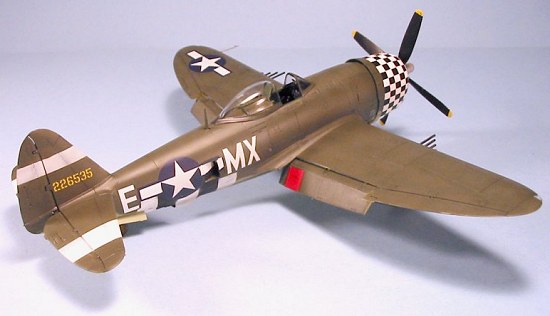 Thunderbolts across
Western Europe in the period between D-Day and V-E Day, that sounds
reasonable. But to Thunderbolt pilots who were there when the
"bubbletop" replaced the "razorback," "Jug" meant milk jug.
Thunderbolts across
Western Europe in the period between D-Day and V-E Day, that sounds
reasonable. But to Thunderbolt pilots who were there when the
"bubbletop" replaced the "razorback," "Jug" meant milk jug.The first "bubbletop" Thunderbolt was the YP-47K, which began life as a P-47D-11RE, and was the second fighter fitted with a "bubble" canopy after the British Hawker Typhoon. Originally scheduled for production as the P-47L, the "super 'Bolt" (as pilots called it originally) began appearing in England in May, 1944, under the designation P-47D-25RE. With an R-2800-59 or -63 engine putting out 2,300 h.p. under war emergency rating, and swinging a Hamilton Standard Hydromatic propeller of 13 feet, 1 7/8 inches diameter, the airplane had increased tankage and the ability to carry a 150-gallon drop tank on the centerline shackles. At first, only flight leaders - group commanders and squadron commanders - received the new airplane. By the end of the summer of 1944, with the high losses sustained in ground attack missions during the Battle of Normandy, the "bubbletop" P-47D-25, -26, and -27 Thunderbolts from Farmingdale (RE) and Evansville (RA) were the standard fighter bomber of the U.S. 9th Army Air Force.
Scenes From The P-47 Juggernaut Across Europe:
Once the American forces were established on the continent. many small airfields appeared across northern France to support the operations of the Thunderbolts. The fields the P-47s flew from were generally temporary - a short runway that was either made of pierced-steel-planking, or just dirt. When a P-47 pilot sat at the end of a 3,500 foot runway, carrying a full ammo load, two 500-pound bombs and a 110-gallon drop tank, successful takeoff could be problematic, especially if it had rained recently. Jack Reynolds of the 412th Fighter Squadron of the 373rd Fighter Group remembered the "Rules for Takeoff" that were posted at the ops office:
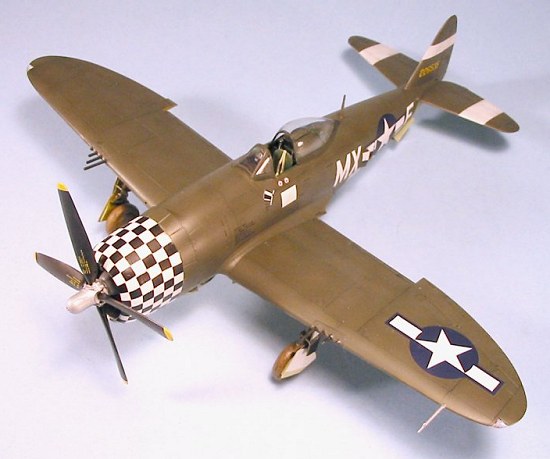 1. Line up on the
runway with the canopy open.
1. Line up on the
runway with the canopy open.
2. Stand on the brakes.
3. Pull the stick all the way back.
4. Push the throttle, mixture, prop control, and turbo to the fire wall.
5. When the tail comes off the ground, ease off the brakes and push the stick forward so you are moving with the tail in the air.
6. With one hand on the throttle quadrant,
7. With one hand on the bomb release,
8. With one hand on the wheel retract handle,
9. With one hand on the cowl flap closer handle,
10. With one hand on the elevator trim wheel,
11. With one hand on the safety belt release,
12. With one hand on the water injection button,
13. With one hand, cross yourself.
14. When you reach the end of the runway, ease the stick back and retract the wheels.
As fellow 412th Fighter Squadron veteran John Rutherford remembers, "There was a very familiar sight at most strips whenever a shot-up P-47 would crash-land. Usually, the pilot would jump out and signal he was OK. Before the dust had settled, an enterprising crew chief would be making off with the canopy for his plane. The instruments would go next, before the salvage crew got there. It beat requisitioning parts and waiting forever."
When an
accident happened on one of these strips, the result was that flight
operations were cancelled until the wreckage was cleared. For those in
the air, this meant finding another small crowded airfield to land at. As
Rutherford recalls, "We came back one time to find our strip inoperative
and were vectored to a neighboring strip about 30 miles away. The home
group there was trying to land, along with another stranded group of
P-47s. We had no radio contact with the controller, so we all got in a
tight landing pattern to try and get on the ground. I recall flying
close formation with several strange P-47s on the crosswind and approach
legs. The strip was too narrow to take more than one at a time, so the
one lucky pilot who was closest to the ground at the decisive moment,
would put down. The rest had to go around again. The
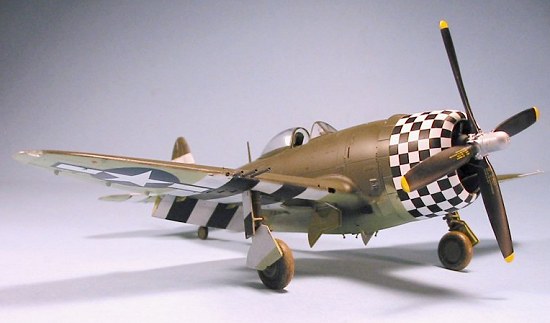 ceiling was about
1,000 feet and dropping. There was a small church with a steeple and
cross about half a mile from the end of the runway we were landing on.
One Thunderbolt managed to knock off the cross, but landed safely. Then
another P-47 hit the steeple and knocked a few feet off it, and landed
safely. A third hit the steeple and reduced it to about half its original
height, and landed safely. Thunderbolts were tough, to take that and
still land!"
ceiling was about
1,000 feet and dropping. There was a small church with a steeple and
cross about half a mile from the end of the runway we were landing on.
One Thunderbolt managed to knock off the cross, but landed safely. Then
another P-47 hit the steeple and knocked a few feet off it, and landed
safely. A third hit the steeple and reduced it to about half its original
height, and landed safely. Thunderbolts were tough, to take that and
still land!"
While there were more than a few moments of "sheer terror" to be faced by a Thunderbolt pilot, not all of them happened under enemy fire. Jack Reynolds remembers an incident that was both terrifying and hilarious in the same moment. "We had a replacement pilot named Ted Buckley in the 411th Squadron who loved French champagne, cognac, you name it. One morning, after a long night in Brussels, he was assigned to make a test hop. He did it, breathing pure oxygen to get the cobwebs out of his brain. Upon landing, he allowed one wheel to get off the runway and hit a crater, and the P-47 flipped on its back, burying the top of the canopy in the dirt so he couldn't get out. A group of us ran out to help. We found him drenched with gasoline, hanging upside down in his harness, cursing like a fiend. Before we had time to do anything, Lt. Ramon Franzalia, from Group Headquarters, ran in under the wing, drew his .45 automatic, pointed it at Buckley's head and said, "Donít' worry Buck, if it starts to burn I'll shoot you!" The rest of us lifted the tail, opened the canopy and released Ole Buck. He got out, swore at Franzalia, and lunged at him but fell down. Franzalia took off running and wasn't seen for two days until Ole Buck had cooled down."
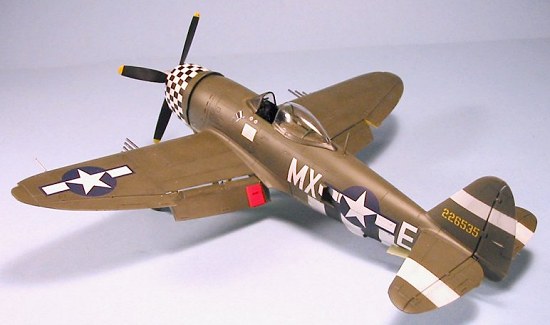 Occasionally,
war could become completely absurd. Jack Reynolds recalls a
particularly-memorable mission: "Col. James McCarthy, the Group C.O., was
leading a squadron of 16 P-47s on an armed recon flight, each carrying
three 500 pound bombs and a full load of 500 rounds per gun. They had
been cruising for two hours over France without seeing anything. Finally,
someone spotted a lone German on a motorcycle high-tailing it down a
country lane.
Occasionally,
war could become completely absurd. Jack Reynolds recalls a
particularly-memorable mission: "Col. James McCarthy, the Group C.O., was
leading a squadron of 16 P-47s on an armed recon flight, each carrying
three 500 pound bombs and a full load of 500 rounds per gun. They had
been cruising for two hours over France without seeing anything. Finally,
someone spotted a lone German on a motorcycle high-tailing it down a
country lane.
"In desperation, McCarthy sent one flight down to drop one 500-pounder on the motorcycle. The pilot missed. Then each man in the first flight came around and dropped one 500 pounder on the motorcycle. All three missed! Then they each went back and dropped the remaining two bombs each. They all missed! The motorcycle was still speeding though the French countryside.
"Then each came back and made a strafing run at the motorcycle. They missed again! The next three flights came down in turn and did the same thing, and they all missed! Just count it up: 1,500 pounds of bombs each, 4,000 rounds of 50-caliber each. Sixteen P-47s made a total of 48 passes, dropping 24,000 pounds of bombs, and firing off 64,000 rounds from 128 machine guns - and they all missed! And all they were shooting at was one lousy German on one lousy motorcycle!! What a story he had to tell back at the barracks! He must have been the luckiest guy in the whole German Army."
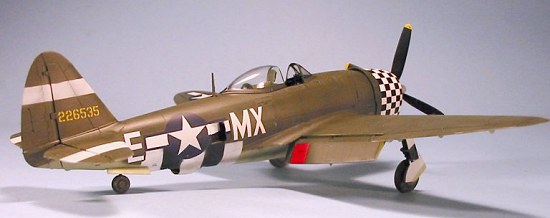 Archie Maltby, a
line pilot of the 388th Fighter Squadron of the 365th Fighter Group, lost
his "razorback" Thunderbolt in air combat over the Foret de Vallone
in northern France on August 18, 1944; he evaded the Germans and escaped
from the British to return to his unit. He later flew close air support
in Operation Market Garden that September and in the Battle of the
Huertgen Forest in October and November. Maltby remembered what it was
like to fly in the Battle of the Bulge: "When the attack first came, with
all the bad weather, we would take off into a 500-foot ceiling, and climb
on instruments to 18,000 feet or so before breaking out. We were
supporting the paratroopers at Bastogne, which is at an altitude of 3,500
feet. We'd get over the area, and drop back into the clouds on
instruments. If we hadn't broken out by the time we got down to 4,500
feet, we had to climb back up, fly home, and let down again, all on
instruments. That's damn hard to do in a P-47, and we lost five guys
before the weather changed. It was wonderful the day the sky broke and
we could give those paratroopers the support they needed! Once the skies
broke, we had the most lucrative hunting of the war. It was a burning
mess out there as we hit everything they had."
Archie Maltby, a
line pilot of the 388th Fighter Squadron of the 365th Fighter Group, lost
his "razorback" Thunderbolt in air combat over the Foret de Vallone
in northern France on August 18, 1944; he evaded the Germans and escaped
from the British to return to his unit. He later flew close air support
in Operation Market Garden that September and in the Battle of the
Huertgen Forest in October and November. Maltby remembered what it was
like to fly in the Battle of the Bulge: "When the attack first came, with
all the bad weather, we would take off into a 500-foot ceiling, and climb
on instruments to 18,000 feet or so before breaking out. We were
supporting the paratroopers at Bastogne, which is at an altitude of 3,500
feet. We'd get over the area, and drop back into the clouds on
instruments. If we hadn't broken out by the time we got down to 4,500
feet, we had to climb back up, fly home, and let down again, all on
instruments. That's damn hard to do in a P-47, and we lost five guys
before the weather changed. It was wonderful the day the sky broke and
we could give those paratroopers the support they needed! Once the skies
broke, we had the most lucrative hunting of the war. It was a burning
mess out there as we hit everything they had."
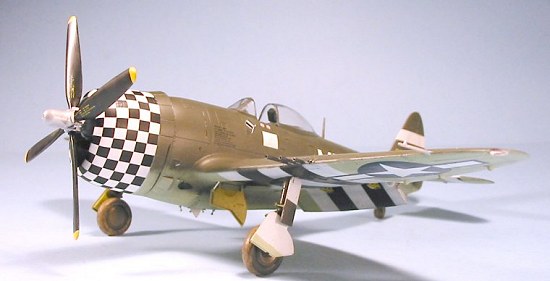 Operating at
low altitude like they did, right in the front lines where flak was
heavy, many Thunderbolt pilots died in their airplanes. Every one of the
P-47 units involved in the fight across Europe after the invasion
suffered more than 100 percent casualties in killed and wounded during
the eleven months between D-Day and V-E Day. The "Jabos," as they were
called by their Wehrmacht enemies, fought the toughest war of any
group of American fighter pilots.
Operating at
low altitude like they did, right in the front lines where flak was
heavy, many Thunderbolt pilots died in their airplanes. Every one of the
P-47 units involved in the fight across Europe after the invasion
suffered more than 100 percent casualties in killed and wounded during
the eleven months between D-Day and V-E Day. The "Jabos," as they were
called by their Wehrmacht enemies, fought the toughest war of any
group of American fighter pilots.
Archie Maltby flew on through the final months and weeks of the war, rising to the rank of Captain in March 1945. "On May 8th, 1945, when we got the word it was over, I was in the squadron operations tent. I looked over at the roster board, and of the thirty-six pilots assigned to the 388th Fighter Squadron, there was me and two others who had flown the D-Day missions. All the others I'd crossed the Channel with that morning were gone. Ten or twelve had finished their tours and made it home; the rest had been shot down, dead or prisoners."
The P-47 fighter-bombers were indispensable to the Allied victory in Europe. As Jack Reynolds says, "If I hadn't been flying the Thunderbolt, I would never have survived my tour." No better compliment can be paid to a combat airplane.
|
THE KIT |
For a look at what is in the box, check out the preview.
|
CONSTRUCTION |
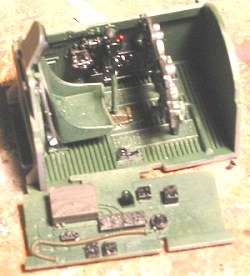 Construction on
this kit began with painting all the detail parts for the cockpit, the
engine, the wheel wells and landing gear. The cockpit parts were painted
with Tamiya "Deep Green," a good match for "Dull Dark Green," while the
gear wells and interior of the gear doors were painted with Tamiya
"Yellow Green", a perfect "Yellow Zinc Chromate. The gear legs and wheel
rims were painted Olive Drab; Tamiya says "silver," but the Army Tech
Order quoted in "Camouflage and Markings: P-47 Thunderbolt in Europe"
specifies Olive Drab. Once all was dry, a light "wash" of thinned Tamiya
"Smoke" was applied to highlight detail, then the parts were given a coat
of Testors Dullcote.
Construction on
this kit began with painting all the detail parts for the cockpit, the
engine, the wheel wells and landing gear. The cockpit parts were painted
with Tamiya "Deep Green," a good match for "Dull Dark Green," while the
gear wells and interior of the gear doors were painted with Tamiya
"Yellow Green", a perfect "Yellow Zinc Chromate. The gear legs and wheel
rims were painted Olive Drab; Tamiya says "silver," but the Army Tech
Order quoted in "Camouflage and Markings: P-47 Thunderbolt in Europe"
specifies Olive Drab. Once all was dry, a light "wash" of thinned Tamiya
"Smoke" was applied to highlight detail, then the parts were given a coat
of Testors Dullcote.
The cockpit is
as well-detailed "out of the box" as any resin aftermarket set I have
seen. I painted the "black boxes" and instrument panel in Tamiya
"semi-gloss black," and highlighted the black boxes with a brush dipped
lightly in SNJ polishing powder; I used the kit decals for the instrument
panel.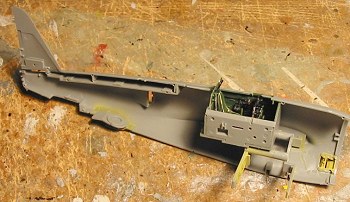
While all that was drying, I assembled the wings. Remember that you have to decide before gluing the flaps together whether you will pose them up or down, since you have to glue in the hinges at that point before gluing top and bottom halves together.
I decided to
attach the upper rear fuselage and fin parts to their respective fuselage
halves before assembly. In retrospect, since this became the one area I
had to sand down joints and use Mr. Surfacer, due to the fact that I
applied glue from the inside, I will assemble these two parts together
first and 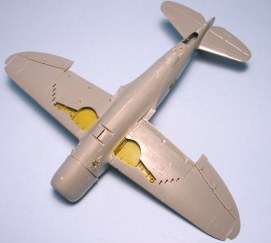 then
assemble them to the fuselage after it is glued together on my future
models (and this is one kit that will end up with more than one example
in my collection!). This will allow better control of the glue without
having to resort to sanding stick and Mr. Surfacer.
then
assemble them to the fuselage after it is glued together on my future
models (and this is one kit that will end up with more than one example
in my collection!). This will allow better control of the glue without
having to resort to sanding stick and Mr. Surfacer.
I then glued the cockpit together, and then attached it to the left fuselage half, then glued the fuselage together. I assembled the engine and the engine cowling, and attached them to the fuselage.
When the fuselage was assembled, I attached the wings and the horizontal stabilizers. The model was set aside to "set up" overnight. I think the entire construction phase - including the pre-painting of detail parts - took under three hours total including drying time for the paint and time for the instrument panel decal to set up. (Editor's Note: Talking to those who have built this kit at this year's Nationals confirm that this is probably the ultimate in easy to build, trouble-free kits so far.)
|
CAMOUFLAGE & MARKINGS |
Painting:
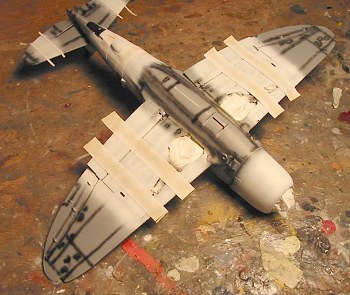 I have always
wanted to do one of those strange 78th Fighter Group P-47D-25s, the ones
with British "Dark Green" for their upper camouflage and British "Sky"
for the lower camouflage color. With their black-and-white checkered
cowlings, they were unlike any other P-47s used by any other unit in the
ETO. Since I had the SuperScale sheet that had the markings for "MX-E",
a well-photographed airplane of the unit - and since I had a couple of
the very good air-to-air photos taken of this airplane during the summer
of 1944 in my Thunderbolt research stash, it was a simple choice to make.
I have always
wanted to do one of those strange 78th Fighter Group P-47D-25s, the ones
with British "Dark Green" for their upper camouflage and British "Sky"
for the lower camouflage color. With their black-and-white checkered
cowlings, they were unlike any other P-47s used by any other unit in the
ETO. Since I had the SuperScale sheet that had the markings for "MX-E",
a well-photographed airplane of the unit - and since I had a couple of
the very good air-to-air photos taken of this airplane during the summer
of 1944 in my Thunderbolt research stash, it was a simple choice to make.
I started
painting by "pre-shading" all the panel lines with flat black. I then
painted the areas of the lower wing and fuselage that would have the
black stripes of the D-Day identification stripes. When that was dry, I
masked off the 18" wide black stripes. I then painted the white
stripes. Yes, this makes it more difficult to get coverage, but
depending on how much coverage you apply, the white stripes - which
weathered badly on operations - can be anything from brand-new to
ready-to-be-taken-off. Remember, these were temporary stripes; I always
wince at models with perfectly-applied stripes, since no airplane that
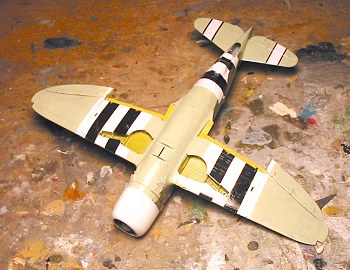 ever carried them had
such stripes. I also painted the tail ID stripes white and painted the
cowling white, in the expectation of applying the black checkerboards
from the SuperScale decal sheet.
ever carried them had
such stripes. I also painted the tail ID stripes white and painted the
cowling white, in the expectation of applying the black checkerboards
from the SuperScale decal sheet.
With the entire of the D-Day stripes masked off, I painted the lower surfaces with Tamiya "Sky," and the upper surfaces with Gunze-Sangyo H-73 "British Dark Green." In both instances, after the original application, I lightened the "Sky" with some flat white and went over the panels; I used Gunze Sangyo "Medium Sea Grey" - which has a distinct violet tone - to lighten the Dark Green, so I would be able to create the UV radiation effect in high altitude sun-fading, which is where the majority of airplanes in the cloudy ETO experienced paint fading.
When everything was dry and unmasked, I gave the model a thorough coat of Future and let it dry overnight.
Decals:
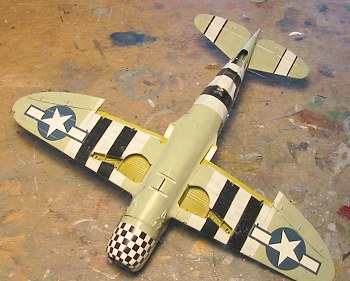 I was wondering
about the SuperScale decals, as regards their fit, since the sheet came
out before this model. I was right to wonder, because the checkerboards
were too small. Additionally, the national insignia was too small as
compared with the photographs of the real MX-E!
I was wondering
about the SuperScale decals, as regards their fit, since the sheet came
out before this model. I was right to wonder, because the checkerboards
were too small. Additionally, the national insignia was too small as
compared with the photographs of the real MX-E!
I ended up using the Tamiya decals for the checkerboards and the fuselage and upper wing insignia, since they are the right size. Unfortunately, since Tamiya expects the modeler to do an airplane with the under wing shackles and separates the insignia so that it will fit, you can't use it for an airplane without the shackles. I found some appropriate-size US insignia in the decal dungeon and used those. The SuperScale decals for the squadron codes, aircraft serial number and personal markings were used. I used the SuperScale stenciling, though did not apply all of it, since I did not think that all would have been re-done after the complete repaint the airplane received in England.
When
everything had set up, I washed the model to get rid of residue, then
gave the model another coat of Future.
|
FINAL CONSTRUCTION |
I applied Tamiya "Smoke" for the exhaust stains, but other than that did little weathering, since these airplanes were pretty clean - they were well-maintained in England, and the period of the D-Day stripes was early in their career, so they likely hadn't had a lot of the new paint scheme wear off yet.
I attached the early gunsight and the canopy in the open position, and attached the landing gear and gear doors. The flaps were attached in the down position. While most photos of P-47s on the ground show them with flaps up, the model looks better with them down, as it is difficult to get the "tight" fit you need with them up. This is the same problem one gets with the Tamiya Mustangs. With the blast tubes and prop attached, the model was finished.
The Tamiya and Hasegawa Jugs Compared:
I took these three photographs of the new Tamiya P-47D-25RE, compared with a Hasegawa P-47D-30RE. I think the first thing one can notice just scanning the three pictures is that the two models are "close" in final "look."
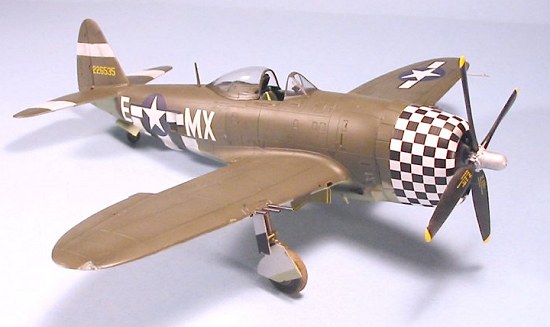 Roughly speaking,
the fuselage of the Tamiya kit is approximately 1/16" deeper in profile
section than the Hasegawa kit. Comparing both with photos in Roger
Freman's "Thunderbolt: A Documentary History of the Republic P-47," my
personal judgment is the Tamiya kit is "more right." However, the
Hasegawa kit is not so "not right" as to be "wrong."
Roughly speaking,
the fuselage of the Tamiya kit is approximately 1/16" deeper in profile
section than the Hasegawa kit. Comparing both with photos in Roger
Freman's "Thunderbolt: A Documentary History of the Republic P-47," my
personal judgment is the Tamiya kit is "more right." However, the
Hasegawa kit is not so "not right" as to be "wrong."
Where the Tamiya kit beats the Hasegawa kit 50 ways from Sunday is "buildability." I have never been able to make the Hasegawa kit (and I have done around ten of them, both versions) without using Evergreen sheet plastic to make a better join for the one-piece lower wing to the fuselage, and I always have to rescribe panel line detail after sanding, puttying, and using Mr. Surfacer there to get a good joint. And, if you are not careful, you can assemble the wing to the fuselage at an incorrect angle of dihedral. There is none of that with the Tamiya kit; it's physically. impossible to get the wing dihedral wrong, and if you are careful in assembling the fuselage, there will be no loss of panel detail in insuring no centerline seam.

Tamiya's propellers are far superior to those of Hasegawa; the only way to do a P-47D-25RE right with the Hasegawa kit is to rob the old Monogram kit of its prop. I do, however, like the fact that any of the Hasegawa "bubbletops" have all the parts necessary to do any sub-type, since the vertical fin extension is in all the kits. Hasegawa's kit only allows you to build an airplane with the flaps up; I like the Tamiya choice, but it's not something one "has to have."
Overall: don't throw away your Hasegawa kits. You can build plenty of nice P-47s with them, if you're willing to put a little extra work into that wing/fuselage attachment. The ultimate result of both looks good, but Tamiya has "the edge." There is that indefinable, know-it-when-you-see-it thing called "quality," and Tamiya wins on that for those of us anal enough to worry about such things.
|
CONCLUSIONS |
I would say I
like these Thunderbolts - both this bubbletop and the earlier razorback -
as much as I like the Tamiya Corsair and Wildcat, which also are honeys
to build out of the box; with this kit, there is nothing to correct, such
as the step cutout in the flap of the Corsair or the cockpit floor of the
Wildcat.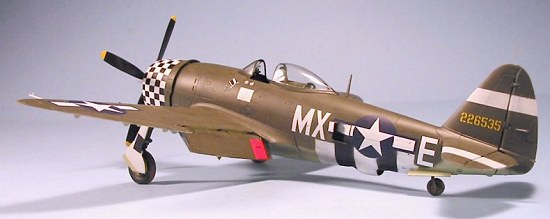
A first-time modeler could take this kit and make a model they would be proud to show their friends; the kit is an "ace-maker," as pilots used to say of the Fokker D.VII. This is one of the best-engineered and most accurate kits it has been my pleasure to build. I know for a fact there will be more of them on the shelves here at Le Chateau du Chat in future months and years. This is going to be one of those kits you can build and build. Buy the decals that will be coming out now, and hoard them for all the future builds!
"Scenes From the P-47 Juggernaut Across Europe" originally appear as episodes in the articles "From D-Day to V-E Day" and "Tail-End Charlie" both written by Thomas McKelvey Cleaver, to be found in the upcoming "P-47 Thunderbolt Special" from Flight Journal.
Thanks to HobbyLink Japan for the review kit.
If you would like your product reviewed fairly and quickly by a site that has over 200,000 visitors a month, please contact me or see other details in the Note to Contributors.